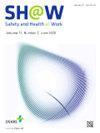地理快餐店密度,工作场所饮食行为和消防员的肥胖
IF 2.9
3区 医学
Q1 PUBLIC, ENVIRONMENTAL & OCCUPATIONAL HEALTH
引用次数: 0
摘要
背景:一般人群的肥胖率受当地食物环境的影响。然而,没有流行病学研究调查工作场所附近的食物环境如何影响肥胖的结果,特别是对于像消防员这样的高肥胖率的职业群体。本文调查了227名职业消防员地理快餐店密度与肥胖之间的直接和间接关系。方法:我们使用三种临床评估的肥胖指标(体重指数、腰围和体脂率)作为结果变量,并通过消防员特定问卷收集自我报告的饮食习惯作为中介变量。我们采用结构方程模型(SEM)来探索直接和间接途径,承认这种分析的探索性,因为职业快餐密度的基础研究有限。结果我们发现GFFRD与肥胖测量之间存在统计学上显著但较小的间接关联,由组织和个人层面的饮食行为介导,对人群层面的职业健康具有潜在影响。研究结果为工作场所附近的食物环境如何通过饮食行为影响肥胖风险提供了证据。这些见解可能为针对消防员和其他轮班工人的饮食习惯进行干预提供信息,以减轻与工作场所相关的肥胖风险。本文章由计算机程序翻译,如有差异,请以英文原文为准。
Geographical Fast-food Restaurant Density, Workplace Eating Behaviors, and Obesity Among Firefighters
Background
Obesity rates in the general population are influenced by the local food environment. However, no epidemiological studies have examined how the food environment near the workplace may influence obesity outcomes, especially for occupational groups like firefighters who have high obesity prevalence. This article investigates the direct and indirect pathways between geographical fast-food restaurant density (GFFRD) and obesity among 227 professional firefighters.
Methods
We used three clinically assessed obesity measures (body mass index, waist circumference, and body fat percent) as outcome variables and self-reported eating habits as mediating variables collected with a firefighter-specific questionnaire. We employed structural equation modeling (SEM) to explore both direct and indirect pathways, acknowledging the exploratory nature of this analysis given the limited foundational research in occupational fast-food density.
Results
We found a statistically significant but small indirect association between GFFRD and obesity measures, mediated by organizational and individual-level eating behaviors, with potential implications for occupational health at a population level.
Conclusions
The study findings contribute to the evidence on how the food environment near the workplace influences obesity risk through eating behaviors. These insights may inform interventions targeting dietary habits in firefighters and other shift workers to mitigate workplace-related obesity risks.
求助全文
通过发布文献求助,成功后即可免费获取论文全文。
去求助
来源期刊

Safety and Health at Work
Social Sciences-Safety Research
CiteScore
6.40
自引率
5.70%
发文量
1080
审稿时长
38 days
期刊介绍:
Safety and Health at Work (SH@W) is an international, peer-reviewed, interdisciplinary journal published quarterly in English beginning in 2010. The journal is aimed at providing grounds for the exchange of ideas and data developed through research experience in the broad field of occupational health and safety. Articles may deal with scientific research to improve workers'' health and safety by eliminating occupational accidents and diseases, pursuing a better working life, and creating a safe and comfortable working environment. The journal focuses primarily on original articles across the whole scope of occupational health and safety, but also welcomes up-to-date review papers and short communications and commentaries on urgent issues and case studies on unique epidemiological survey, methods of accident investigation, and analysis. High priority will be given to articles on occupational epidemiology, medicine, hygiene, toxicology, nursing and health services, work safety, ergonomics, work organization, engineering of safety (mechanical, electrical, chemical, and construction), safety management and policy, and studies related to economic evaluation and its social policy and organizational aspects. Its abbreviated title is Saf Health Work.
 求助内容:
求助内容: 应助结果提醒方式:
应助结果提醒方式:


